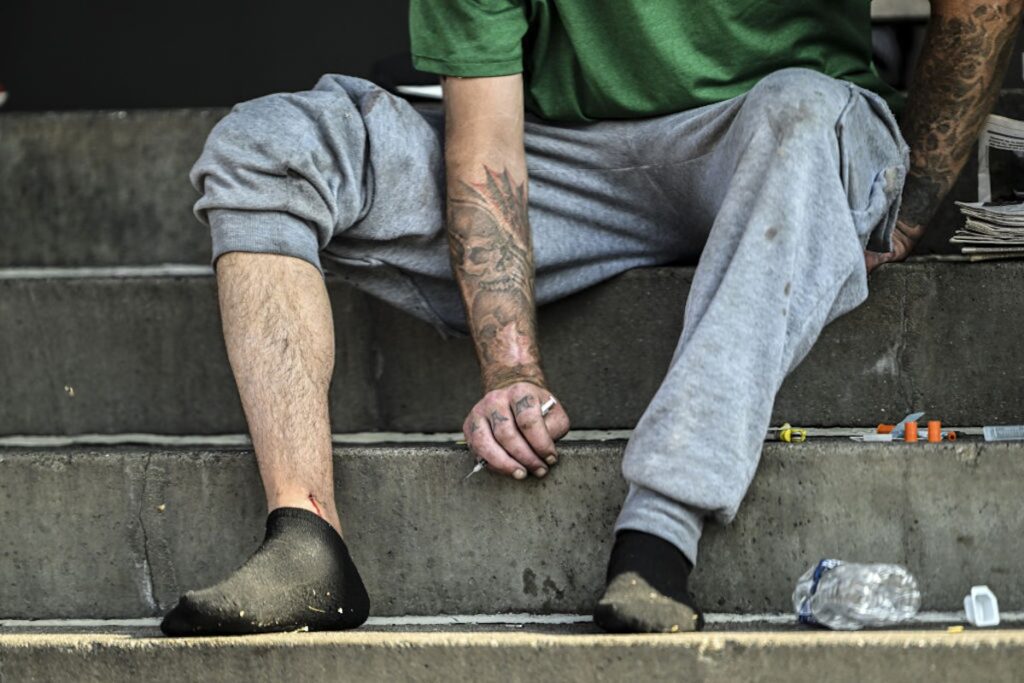The infiltration of a cheap, lethal horse tranquilizer, known as Xylazine or “tranq”, into the illegal drug market across the United States is causing grave concern for the Drug Enforcement Agency (DEA). Zhuji, a city in the Zhejiang province in eastern China, has emerged as a primary base of production for this dangerous substance, which has subsequently been surfacing in alarming quantities in U.S. cities such as San Francisco, Philadelphia, and New York.
They are getting high on fentanyl laced with xylazine (xylazine is used as an animal tranquilizer). Known as tranq or the zombie drug in the streets of America's Garden Capital. pic.twitter.com/2R1LDh8zBX
— Weird And Terrifying (@WeirdTerrify) July 18, 2023
Known as the “zombie drug,” Xylazine is notorious for causing disturbing skin lesions that mimic the appearance of rotting flesh, in severe cases eroding down to the bone. Its perilous effects extend beyond the physical, as the drug holds the ability to slow a person’s heart rate and breathing patterns to the point of complete cessation, leaving users in a catatonic state or, tragically, taking their lives.
Dangerously, drug dealers have been found to mix Xylazine with fentanyl, a powerful synthetic opioid, to amplify and prolong the high experienced by users. The concoction of these two drugs does not just serve to heighten the feeling of euphoria but creates a potentially fatal cocktail. “Tranq” has also been detected alongside other drugs such as meth and cocaine.
The DEA believes this new addition to the illegal drug trade is increasing the deadliness of an already critical drug crisis. “Xylazine is making the deadliest drug threat our country has ever faced – fentanyl – even deadlier,” DEA Administrator Anne Milgram stated in a recent public safety alert. In 2022 alone, DEA seizures revealed Xylazine in approximately 23% of fentanyl powder and 7% of fentanyl pills.
The Centers for Disease Control and Prevention (CDC) reports a significant increase in fentanyl-related fatalities involving the use of Xylazine, observing a rise from 2.9% to 10.9% within 20 states and the District of Columbia over a three and a half-year period from 2019 to 2022.
Narcan, an emergency opioid reversal drug, has demonstrated inefficacy in cases of Xylazine intake due to its non-opioid categorization. However, in the event of an overdose situation, the DEA still advises the administration of Narcan given the possibility of other drug ingestion. Regrettably, routine toxicological screenings fail to identify Xylazine.
Despite these potent and life-threatening side effects associated with Xylazine, it is not currently recognized as a federally controlled substance. This lax classification has led to greater accessibility than illicit drugs such as heroin, though efforts have been made by several states to tighten these parameters. There has been a push for bipartisan legislation in the Congress to reclassify Xylazine as a Schedule III drug under the Controlled Substances Act, which although introduced, has yet to pass.
Ohio is one of the states leading the charge against ‘tranq’, with Republican Governor Mike DeWine addressing the urgency by establishing an executive order for classification of Xylazine as a Schedule III controlled substance. Similar movements have been seen in various major cities on both coasts.
The lethal consequences associated with this ‘tranq’ on our streets underline the need for urgent policy intervention, stringent regulation, and relentless law enforcement action against this rapidly proliferating ‘flesh-rotting’ drug.



